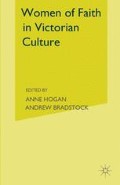Abstract
The figure of the Virgin Mary was symbolically charged and highly visible in Victorian England.1 A marker of Roman Catholicism in England since the Henrician schism and the ensuing Protestantization of the Church of England, she became even more controversial in the middle decades of the nineteenth century, as members of the Oxford Movement revived and expanded the Marian devotion of the seventeenth-century divines.2 Other Anglicans challenged this revival and accused the Tractarians of leaning towards Rome or even of being secret Roman Catholics. So pronounced was the anxiety aroused by the Virgin Mary that in 1845, the year that John Henry Newman and other prominent Anglicans converted to Roman Catholicism, John Keble, one of the leaders of the Oxford Movement, was persuaded by friends not to publish a Marian poem, ‘Mother out of sight’, for fear that it might signal a sympathy towards Roman Catholicism.3
Access this chapter
Tax calculation will be finalised at checkout
Purchases are for personal use only
Preview
Unable to display preview. Download preview PDF.
Notes
The resurgence of Roman Catholicism, which began with Catholic Emancipation in 1829 and continued with the wave of the conversions to Roman Catholicism by prominent Anglicans at mid-century and the re-establishment of the Roman Catholic hierarchy in 1850, also contributed to the Virgin Mary’s prominence, for both the converts and the newly appointed Cardinal of Westminster, Nicholas Wiseman, emphasized Marian devotion. For more on Roman Catholicism and the Virgin Mary in Victorian England, see John Singleton, ‘The Virgin Mary and Religious Conflict in Victorian Britain’, Journal of Ecclesiastical History, 43, No. 1 (January 1992), 16–34.
J.T. Coleridge, A memoir of the Rev. John Keble 3rd edn. (Oxford and London: James Parker, 1870), p. 292.
Deborah Gorham, The Victorian Girl and the Feminine Ideal (Bloomington: Indiana University Press, 1982), pp. 744.
For a study of Victorian attitudes towards Roman Catholic converts, see Walter Arnstein, Protestant Versus Catholic in Mid-Victorian England: Mr Newdegate and the Nuns (Columbia: University of Missouri Press, 1982).
F.G. Lee, The Truth as it is in Jesus: A sermon preached at the Church of S. Martin, Leicester, on Monday, March 2, 1868, at the opening of the Lent Assizes (London: Joseph Masters, 1868), p. 3.
E.B. Pusey, Letter to the Right Rev. Father in God, Richard Lord Bishop of Oxford, on the tendency to Romanism imputed to doctrines held of old, as now, in the English Church (Oxford: J.H. Parker, London: J.G. & F. Rivington, 1839), p. 199
Lewis Morris, ‘Motherhood: an ode’, in Orby Shipley, ed., Carmina Mariana: an English Anthology in Verse in Honour of or in Relation to the Blessed Virgin Mary (London: Spottiswoode, 1893), p. 250.
Catherine Sinclair, Popish Legends of Bible Truths (London: Longman, Brown, Green and Longmans, 1852), p. xxiii.
George Miller, A Letter to the Rev. E.B. Pusey, D.D., in Reference to his Letter to the Lord Bishop of Oxford (London: Duncan and Malcolm, 1840), pp. 4–5.
Janice Capel Anderson, ‘Mary’s Difference: Gender and Patriarchy in the Birth Narratives’, Journal of Religion, 67, No. 2 (April 1987), 195–6.
As Joan Bellamy has noted, ‘The destiny of the true heroine [of the Victorian novel] was to marry and it is with a declaration of love, or the proposal that the nineteenth-century novel generally ends’; Bellamy, ‘Barriers of Silence: women in Victorian fiction’, in Eric Sigsworth, ed., In Search of Victorian Values: Aspects of Nineteenth-century Thought and Society (New York: Manchester University Press, 1988), p. 134.
Archer Gurney, ‘The Communion of the Saints’, in Orby Shipley, ed., Lyra Mystica: Hymns and Verses on Sacred Subjects, Ancient and Modern (London: Longman, Green, Longman, Roberts and Green, 1865), p. 21.
Earl of Redesdale and Charles L. Wood, The Doctrine of the Real Presence (London: John Murray, 1879), p. 23.
John Keble, ‘The Annunciation’, The Christian Year (New York: Thomas Cromwell, 1890, first published 1827), p. 232.
W.T. Maudson, ‘The Dogma of the Virgin Mary’s Immaculate Conception: A Sermon’, (The Pulpit, 67, No. 1, 784 (8 March 1855), 239.
John E. Armstrong, Armstrong’s Reply to Wiseman’s Pastoral Letter on the Immaculate Conception (London: Wertheim and Macintosh, 1855), p. 9
William Ford Vance, On the Invocation of Angels, Saints, and the Virgin Mary (London: James Nisbet, 1828), p. 41
J. Endell Tyler, Primitive Christian Worship: or, the Evidence of Holy Scripture and the Church, Concerning the Invocation of Saints and Angels, and the Blessed Virgin Mary (London: J.G.F. & J. Rivington, 1840), p. 284
J. Endell Tyler, The Worship of the Blessed Virgin Mary in the Church of Rome Contrary to Holy Scripture, and to the Faith and Practice of the Church of Christ though the First Five Centuries (London: Richard Bentley, 1844), pp. 87–8
M. Hobart Seymour, A Pilgrimage to Rome (London: Seeleys, 1848), p. 508
Editor information
Editors and Affiliations
Copyright information
© 1998 Palgrave Macmillan, a division of Macmillan Publishers Limited
About this chapter
Cite this chapter
Engelhardt, C.M. (1998). The Paradigmatic Angel in the House: The Virgin Mary and Victorian Anglicans. In: Hogan, A., Bradstock, A. (eds) Women of Faith in Victorian Culture. Palgrave Macmillan, London. https://doi.org/10.1007/978-1-349-26749-1_12
Download citation
DOI: https://doi.org/10.1007/978-1-349-26749-1_12
Publisher Name: Palgrave Macmillan, London
Print ISBN: 978-1-349-26751-4
Online ISBN: 978-1-349-26749-1
eBook Packages: Palgrave Literature & Performing Arts CollectionLiterature, Cultural and Media Studies (R0)

